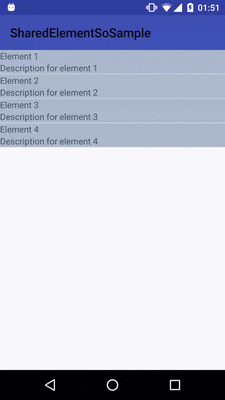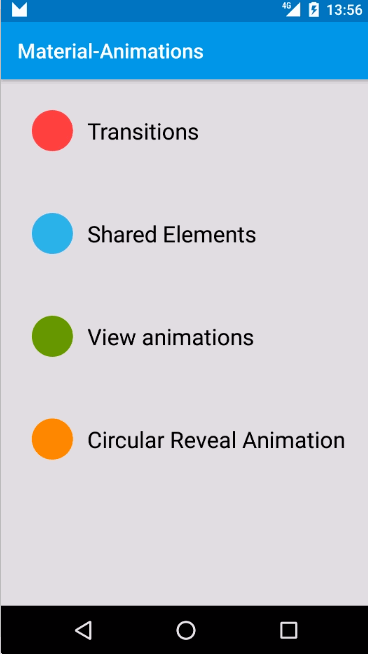Android - How to create a transition from an item in listview to a whole activity?
I build a small sample application that transitions between two activities with the desired effect:
However the transitions in the provided gifs are slightly different. Thetransition in the gif on the left side transitions the list element into the content area of the second activity (Toolbar stays in place). In the gif on the right side the transition transforms the list element into the complete screen of the second activity. The following code provides the effect in the left gif. However it should be possible to adapt the solution with minor modifications to achieve the transition in the right gif.
Note this only works on Lollipop. However it is possible to mock a different effect on older devices.Furthermore the sole purpose of the provided code is to show how it could be done. Don't use this directly in your app.
MainActivity:
public class MainActivity extends AppCompatActivity { MyAdapter myAdapter; @Override protected void onCreate(Bundle savedInstanceState) { super.onCreate(savedInstanceState); setContentView(R.layout.activity_main); setSupportActionBar((Toolbar) findViewById(R.id.toolbar)); ListView listView = (ListView) findViewById(R.id.list_view); myAdapter = new MyAdapter(this, 0, DataSet.get()); listView.setAdapter(myAdapter); listView.setOnItemClickListener(new AdapterView.OnItemClickListener() { @Override public void onItemClick(AdapterView<?> parent, final View view, final int position, long id) { startTransition(view, myAdapter.getItem(position)); } }); } private void startTransition(View view, Element element) { Intent i = new Intent(MainActivity.this, DetailActivity.class); i.putExtra("ITEM_ID", element.getId()); Pair<View, String>[] transitionPairs = new Pair[4]; transitionPairs[0] = Pair.create(findViewById(R.id.toolbar), "toolbar"); // Transition the Toolbar transitionPairs[1] = Pair.create(view, "content_area"); // Transition the content_area (This will be the content area on the detail screen) // We also want to transition the status and navigation bar barckground. Otherwise they will flicker transitionPairs[2] = Pair.create(findViewById(android.R.id.statusBarBackground), Window.STATUS_BAR_BACKGROUND_TRANSITION_NAME); transitionPairs[3] = Pair.create(findViewById(android.R.id.navigationBarBackground), Window.NAVIGATION_BAR_BACKGROUND_TRANSITION_NAME); Bundle b = ActivityOptionsCompat.makeSceneTransitionAnimation(MainActivity.this, transitionPairs).toBundle(); ActivityCompat.startActivity(MainActivity.this, i, b); }}activity_main.xml:
<LinearLayout xmlns:android="http://schemas.android.com/apk/res/android" android:layout_width="match_parent" android:layout_height="match_parent" android:orientation="vertical"> <android.support.v7.widget.Toolbar android:id="@+id/toolbar" android:layout_width="match_parent" android:layout_height="?attr/actionBarSize" android:background="@color/colorPrimary" android:transitionName="toolbar" /> <ListView android:id="@+id/list_view" android:layout_width="match_parent" android:layout_height="match_parent" /></LinearLayout>DetailActivity:
public class DetailActivity extends AppCompatActivity { @Override protected void onCreate(Bundle savedInstanceState) { super.onCreate(savedInstanceState); setContentView(R.layout.activity_detail); setSupportActionBar((Toolbar) findViewById(R.id.toolbar)); long elementId = getIntent().getLongExtra("ITEM_ID", -1); Element element = DataSet.find(elementId); ((TextView) findViewById(R.id.title)).setText(element.getTitle()); ((TextView) findViewById(R.id.description)).setText(element.getDescription()); // if we transition the status and navigation bar we have to wait till everything is available TransitionHelper.fixSharedElementTransitionForStatusAndNavigationBar(this); // set a custom shared element enter transition TransitionHelper.setSharedElementEnterTransition(this, R.transition.detail_activity_shared_element_enter_transition); }}activity_detail.xml:
<LinearLayout xmlns:android="http://schemas.android.com/apk/res/android" android:layout_width="match_parent" android:layout_height="match_parent" android:orientation="vertical"> <android.support.v7.widget.Toolbar android:id="@+id/toolbar" android:layout_width="match_parent" android:layout_height="?attr/actionBarSize" android:background="@color/colorPrimary" android:transitionName="toolbar" /> <LinearLayout android:layout_width="match_parent" android:layout_height="wrap_content" android:background="#abc" android:orientation="vertical" android:paddingBottom="200dp" android:transitionName="content_area" android:elevation="10dp"> <TextView android:id="@+id/title" android:layout_width="match_parent" android:layout_height="wrap_content" /> <TextView android:id="@+id/description" android:layout_width="match_parent" android:layout_height="wrap_content" /> </LinearLayout></LinearLayout>detail_activity_shared_element_enter_transition.xml (/res/transition/):
<?xml version="1.0" encoding="utf-8"?><transitionSet xmlns:android="http://schemas.android.com/apk/res/android" android:transitionOrdering="together"> <changeBounds/> <changeTransform/> <changeClipBounds/> <changeImageTransform/> <transition class="my.application.transitions.ElevationTransition"/></transitionSet>my.application.transitions.ElevationTransition:
@TargetApi(Build.VERSION_CODES.LOLLIPOP)public class ElevationTransition extends Transition { private static final String PROPNAME_ELEVATION = "my.elevation:transition:elevation"; public ElevationTransition() { } public ElevationTransition(Context context, AttributeSet attrs) { super(context, attrs); } @Override public void captureStartValues(TransitionValues transitionValues) { captureValues(transitionValues); } @Override public void captureEndValues(TransitionValues transitionValues) { captureValues(transitionValues); } private void captureValues(TransitionValues transitionValues) { Float elevation = transitionValues.view.getElevation(); transitionValues.values.put(PROPNAME_ELEVATION, elevation); } @Override public Animator createAnimator(ViewGroup sceneRoot, TransitionValues startValues, TransitionValues endValues) { if (startValues == null || endValues == null) { return null; } Float startVal = (Float) startValues.values.get(PROPNAME_ELEVATION); Float endVal = (Float) endValues.values.get(PROPNAME_ELEVATION); if (startVal == null || endVal == null || startVal.floatValue() == endVal.floatValue()) { return null; } final View view = endValues.view; ValueAnimator a = ValueAnimator.ofFloat(startVal, endVal); a.addUpdateListener(new ValueAnimator.AnimatorUpdateListener() { @Override public void onAnimationUpdate(ValueAnimator animation) { view.setElevation((float)animation.getAnimatedValue()); } }); return a; }}TransitionHelper:
public class TransitionHelper { public static void fixSharedElementTransitionForStatusAndNavigationBar(final Activity activity) { if (Build.VERSION.SDK_INT < Build.VERSION_CODES.LOLLIPOP) return; final View decor = activity.getWindow().getDecorView(); if (decor == null) return; activity.postponeEnterTransition(); decor.getViewTreeObserver().addOnPreDrawListener(new ViewTreeObserver.OnPreDrawListener() { @TargetApi(Build.VERSION_CODES.LOLLIPOP) @Override public boolean onPreDraw() { decor.getViewTreeObserver().removeOnPreDrawListener(this); activity.startPostponedEnterTransition(); return true; } }); } public static void setSharedElementEnterTransition(final Activity activity, int transition) { if (Build.VERSION.SDK_INT < Build.VERSION_CODES.LOLLIPOP) return; activity.getWindow().setSharedElementEnterTransition(TransitionInflater.from(activity).inflateTransition(transition)); }}So what are the different parts here:We have two activities. During the transition four views are transitioned between the activities.
Toolbar: like in the left gif the toolbar doesn't move with the rest of the content.
ListView element View -> becomes the content view of the DetailActivity
StatusBar and NavigationBar Background: If we don't add these views to the set of transitioned views they will fade out and back in during the transition. This however requires to delay the enter transition (see:
TransitionHelper.fixSharedElementTransitionForStatusAndNavigationBar)
In the MainActivity the transitioned views are added to the Bundle that is used to start the DetailActivity. Furthermore the transitioned views need to be named (transitionName) in both activities. This can be done in the layout xml as well as programatically.
The default set of transitions, that is used during the shared element transition, affects different aspects of the view(for example: view bounds - see 2). However differences in the elevation of a view are not animated. This is why the presented solution utilizes the custom ElevationTransition.
try this.. Material-Animations
blueIconImageView.setOnClickListener(new View.OnClickListener() { @Override public void onClick(View v) { Intent i = new Intent(MainActivity.this, SharedElementActivity.class); View sharedView = blueIconImageView; String transitionName = getString(R.string.blue_name); ActivityOptions transitionActivityOptions = ActivityOptions.makeSceneTransitionAnimation(MainActivity.this, sharedView, transitionName); startActivity(i, transitionActivityOptions.toBundle()); }});
The Animation you need is called Activity Transitions between shared elements.By Research I found that you should:
- Put your ListView view in a relativeLayout
- OnClick, inflate a copy of your renderer
- Find the global coordinates for where the renderer sits inrelationship to the parent of the ListView
- Add the copied renderer to the RelativeLayout (parent of ListView)
- Animate the listView away
- On the end of that animate, animate your new renderer
Profit!
public class MainActivity extends Activity { private RelativeLayout layout; private ListView listView; private MyRenderer selectedRenderer; @Override protected void onCreate(Bundle savedInstanceState) { super.onCreate(savedInstanceState); layout = new RelativeLayout(this); setContentView(layout); listView = new ListView(this); RelativeLayout.LayoutParams rlp = new RelativeLayout.LayoutParams( RelativeLayout.LayoutParams.MATCH_PARENT, RelativeLayout.LayoutParams.MATCH_PARENT); layout.addView(listView, rlp); listView.setAdapter(new MyAdapter()); listView.setOnItemClickListener(new AdapterView.OnItemClickListener() { @Override public void onItemClick(AdapterView<?> parent, View view, int position, long id) { // find out where the clicked view sits in relationship to the // parent container int t = view.getTop() + listView.getTop(); int l = view.getLeft() + listView.getLeft(); // create a copy of the listview and add it to the parent // container // at the same location it was in the listview selectedRenderer = new MyRenderer(view.getContext()); RelativeLayout.LayoutParams rlp = new RelativeLayout.LayoutParams(view.getWidth(), view .getHeight()); rlp.topMargin = t; rlp.leftMargin = l; selectedRenderer.textView.setText(((MyRenderer) view).textView.getText()); layout.addView(selectedRenderer, rlp); view.setVisibility(View.INVISIBLE); // animate out the listView Animation outAni = new TranslateAnimation(Animation.RELATIVE_TO_SELF, 0f, Animation.RELATIVE_TO_SELF, -1f, Animation.RELATIVE_TO_SELF, 0f, Animation.RELATIVE_TO_SELF, 0f); outAni.setDuration(1000); outAni.setFillAfter(true); outAni.setAnimationListener(new Animation.AnimationListener() { @Override public void onAnimationStart(Animation animation) { } @Override public void onAnimationRepeat(Animation animation) { } @Override public void onAnimationEnd(Animation animation) { ScaleAnimation scaleAni = new ScaleAnimation(1f, 1f, 1f, 2f, Animation.RELATIVE_TO_SELF, 0.5f, Animation.RELATIVE_TO_SELF, 0.5f); scaleAni.setDuration(400); scaleAni.setFillAfter(true); selectedRenderer.startAnimation(scaleAni); } }); listView.startAnimation(outAni); } }); } public class MyAdapter extends BaseAdapter { @Override public int getCount() { return 10; } @Override public String getItem(int position) { return "Hello World " + position; } @Override public long getItemId(int position) { return position; } @Override public View getView(int position, View convertView, ViewGroup parent) { MyRenderer renderer; if (convertView != null) renderer = (MyRenderer) convertView; else renderer = new MyRenderer(MainActivity.this); renderer.textView.setText(getItem(position)); return renderer; } } public class MyRenderer extends RelativeLayout { public TextView textView; public MyRenderer(Context context) { super(context); setPadding(20, 20, 20, 20); setBackgroundColor(0xFFFF0000); RelativeLayout.LayoutParams rlp = new RelativeLayout.LayoutParams( RelativeLayout.LayoutParams.WRAP_CONTENT, RelativeLayout.LayoutParams.WRAP_CONTENT); rlp.addRule(CENTER_IN_PARENT); textView = new TextView(context); addView(textView, rlp); } } }
